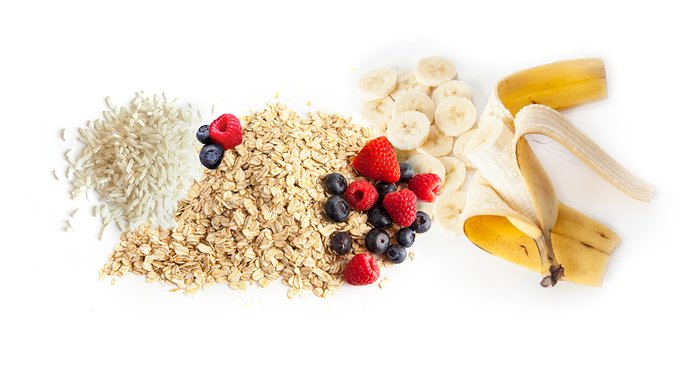The winds of dietary change often shift: One minute, butter is in, the next it's out. Red wine is bad for you until it's good for you. And don't get me started on coffee and chocolate.
The same is true when it comes to the role carbs play in enhancing athletic performance and fitness. Carbs used to be considered the bane of athletic performance—until they became performance fuel. Today there's a resurgence in popularity of low-carb, high-fat (LCHF) diets. And so the wheel turns again.
The fact of the matter is that if you're a performance-minded individual, recent research seems to support LCHF diets as the most efficient way to improve strength, performance, and overall fitness. But what if you could get the benefits of a LCHF diet without having to lower your daily carbohydrate intake? That would be pretty sweet.
Making this kind of win-win more likely is a recent paradigm shift in sports nutrition. According to the new "train low, compete high" model, you can improve your performance by manipulating your carbohydrate timing to perform a few targeted low-intensity training sessions per week in a glycogen-depleted state.
Without consuming any carbs prior to your workout, you can upregulate your aerobic adaptations, while upping your carb intake elsewhere during the day to prepare yourself for a higher-intensity resistance training session. Glycogen depletion paired with restricting carb intake is the key to boosting your work capacity through this strategy.
Let's have a look at how this is actually achieved.
What Do We Mean by "Aerobic Adaptations"?
Your muscle cells, like all the cells in your body, produce energy in an area of the cell known as the mitochondria. By training in a low-carb state, you can increase the number of mitochondria in your muscle cells. The more mitochondria, the greater your body's capacity to produce energy, as well as to produce and transport oxygen to working muscles.

This combination of increased mitochondria and improved transport of oxygen to your muscles is the aerobic adaptation that increases your aerobic capacity and leads to better performance.
You can optimize these adaptations by properly structuring when you get your carbs.
Traditionally, sports nutrition experts have encouraged athletes to maintain a constant level of daily macronutrient intake, on the theory that the body divides these macros more or less equally throughout the day.
The traditional approach to carbohydrates has been to sustain performance by consuming a lot of carbs before, during, and after training. But all this was thrown into question when researchers noticed that athletes performed well in targeted trainingsessions while in a low-carb state.[1]
What this means is you don't have to constantly consume carbs all day long. In fact, by decreasing your carb intake before low-intensity cardiovascular training (LIT) and raising it before high-intensity interval training (HIIT) or resistance training, you can get the benefits of a LCHF diet without lowering your overall daily carb intake.
Timing and Structure for Carbohydrate Intake: Then Versus Now
A typical protocol would be to consume your normal carbohydrate intake over the course of the day so you have all the carbs on board you need for your evening HIIT or strength workout. After the workout, you would reduce your carb intake, consuming protein and fat instead, and wake up ready to perform your morning LIT workout in a glucose-fasted state. This is a perfectly good way to train, and one study done in triathletes showed it significantly increased performance, including reduced time to complete a 10-kilometer run.[2]
Under the new paradigm, you would still plan to do your morning LIT session in a low-glycogen state after a night of carb fasting. The critical difference in the new approach is that you would continue to withhold carbs for three hours after that training. The reason: During this low-glucose, post-workout period, you experience the best adaptive response.[3]

Once the three hours have passed, you would then resume carb consumption at lunchtime and in the meals running up to your HIIT or strength workout later in the day.
If you prefer to do HIIT or strength training in the morning, reverse the process. In one study, well-trained athletes ate a high-carbohydrate breakfast two hours before a glycogen-depleting, high-intensity training session. They didn't consume any more carbs until just before performing a second, lighter session later in the day while glycogen-depleted.[4]
During Your Low-Carb State, Avoid ALL Carbs
You want to carefully time when you consume carbs before and after a workout, but you need to pay attention to any carbs you take on during a session, too. In one study, subjects who were already glycogen-depleted consumed a glucose-containing sports drink during subsequent training. Doing so negated any aerobic adaptations they might have gained.[5]
By carefully monitoring when you consume your carbs, you can get the benefit of a low-carb diet without having to reduce your carbs, which is a beautiful thing. Wait until the carbs you have consumed have a chance to convert into glucose before you begin a HIIT session. And you don't need to follow this paradigm for every workout. Pick 3-4 targeted LIT sessions a week and plan your carb consumption around them.
References
Impey, S. G., Hammond, K. M., Shepherd, S. O., Sharples, A. P., Stewart, C., Limb, M., ... & Close, G. L. (2016). Fuel for the work required: a practical approach to amalgamating train‐low paradigms for endurance athletes. Physiological Reports, 4(10), e12803.
Marquet, L. A., Brisswalter, J., Louis, J., Tiollier, E., Burke, L., Hawley, J., & Hausswirth, C. (2016). Enhanced Endurance Performance by Periodization of CHO Intake:" sleep low" strategy. Medicine and Science in Sports and Exercise, 48(4), 663-672.
Bartlett, J. D., Louhelainen, J., Iqbal, Z., Cochran, A. J., Gibala, M. J., Gregson, W., ... & Morton, J. P. (2013). Reduced carbohydrate availability enhances exercise-induced p53 signaling in human skeletal muscle: implications for mitochondrial biogenesis. American Journal of Physiology-Regulatory, Integrative and Comparative Physiology, 304(6), R450-R458.
Cox, G. R., Clark, S. A., Cox, A. J., Halson, S. L., Hargreaves, M., Hawley, J. A., ... & Burke, L. M. (2010). Daily training with high carbohydrate availability increases exogenous carbohydrate oxidation during endurance cycling. Journal of Applied Physiology, 109(1), 126-134.
Morton, J. P., Croft, L., Bartlett, J. D., MacLaren, D. P., Reilly, T., Evans, L., ... & Drust, B. (2009). Reduced carbohydrate availability does not modulate training-induced heat shock protein adaptations but does upregulate oxidative enzyme activity in human skeletal muscle. Journal of Applied Physiology, 106(5), 1513-1521.



